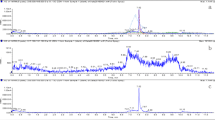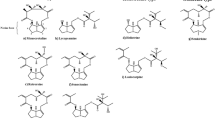Abstract
Analytical methods including solvent extraction followed by gas chromatography/ion-trap (GC/IT) with scan and MS/MS mode, a GC/mass selective detector (GC/MSD), and liquid chromatography/triple quadrupole mass spectrometers (LC/MS/MS) were optimized to identify and quantify terbutryn. The spike recovery was 96.5% using GC/IT with scan mode and 103.5% with MS/MS mode, 90.3% by GC/MSD, and 92.5% by LC/MS/MS. The limit of detection (LOD) was 0.0015 mg/kg by GC/IT with scan, 0.026 mg/kg with MS/MS mode, 0.015 mg/kg with GC/MSD, and 0.026 mg/kg by LC/MS/MS. Of the four methods, GC/IT with scan mode was determined to be the most sensitive (with LOD: 0.0015 mg/kg and limit of quantitation (LOQ): 0.0047 mg/kg), rapid (retention time: 9.6 min) and the most precise method (relative standard deviation: 17%) for the quantification of terbutryn. GC/IT with scan mode proved to be the more sensitive analytical method for terbutryn than other methods in this study, showing better accuracy and rapid analysis.
Similar content being viewed by others
References
Wang S, Zhao P, Min G, Fang G. Multi-residue determination of pesticides in water using multi-walled carbon nanotubes solid-phase extraction and gas chromatography–mass spectrometry. J. Chromatogr. A. 1165: 166–171 (2007).
Frıas S, Sánchez MJ, Rodrıguez MA. Determination of triazine compounds in ground water samples by micellar electrokinetic capillary chromatography. Anal. Chem. Acta. 503: 271–278 (2004).
Larsen L, Sørensen SR, Aamand J. Mecoprop, isoproturon, and atrazine in and above a sandy aquifer: vertical distribution of mineralization potential. Environ. Sci. Technol. 34: 2426–2430 (2000).
Nilson EL, Unz RF. Antialgal substances for iodine-disinfected swimming pools. Appl. Environ. Microbiol. 34: 815–822 (1977).
Velisek J, Stara A, Kolarova J, Svobodova Z. Biochemical, physiological and morfological responses in common carp (Cyprinus carpio L.) after long-term exposure to terbutryn in real environmental concentration. Pest Biochem. Physiol. 100: 305–313 (2011).
U.S. Environmental Protection Agency. Fact Sheet Number 104: Terbutryn, U.S. EPA, Washington, DC, USA (1986).
Villarini M, Scassellati-Sforzolini G, Moretti M, Pasquini R. In vitro genotoxicity of terbutryn evaluated by the alkaline single-cell microgel-electrophoresis” comet” assay. Cell Biol. Toxicol. 16: 285–292 (2000).
NHMRC N. Australian drinking water guidelines paper 6 national water quality management strategy. National Health and Medical Research Council, National Resource Management Ministerial Council, Commonwealth of Australia, Canberra, Australia (2011).
Lewis RJ. Sax’s dangerous properties of industrial materials. 10th ed. Vol. 3. Van Nostrand Reinhold, New York, USA (2000).
Lehotay SJ. Multiclass, multiresidue analysis of pesticides, strategies for Encyclopedia of Analytical Chemistry. Wiley, Chichester (2000).
Quednow K, Püttmann W. Monitoring terbutryn pollution in small rivers of Hesse, Germany. J. Environ. Monitor. 9: 1337–1343 (2007).
Lapworth DJ, Gooddy DC, Stuart ME, Chilton PJ, Cachandt GC, Knapp M, Bishop S. Pesticides in groundwater: some observations on temporal and spatial trends. Water Environ. J. 20: 55–64 (2006).
Djozan D, Ebrahimi B, Mahkam M, Farajzadeh MA. Evaluation of a new method for chemical coating of aluminum wire with molecularly imprinted polymer layer. Application for the fabrication of triazines selective solid-phase microextraction fiber. Anal. Chem. Acta. 674: 40–48 (2010).
Djozan D, Mahkam M, Ebrahimi B. Preparation and binding study of solid-phase microextraction fiber on the basis of ametryn-imprinted polymer: application to the selective extraction of persistent triazine herbicides in tap water, rice, maize and onion. J. Chromatogr. A. 1216: 2211–2219 (2009).
Gao S, You J, Zheng X, Wang Y, Ren R, Zhang R, Bai Y, Zhang H. Determination of phenylurea and triazine herbicides in milk by microwave assisted ionic liquid microextraction high-performance liquid chromatography. Talanta 82: 1371–1377 (2010).
Hernández F, Serrano R, Miralles MC, Font N. Gas and liquid chromatography and enzyme linked immuno sorbent assay in pesticide monitoring of surface water from the western mediterranean (Comunidad Valenciana, Spain). Chromatographia 42: 151–158 (1996).
Maloschik E, Ernst A, Hegedűs G, Darvas B, Székács A. Monitoring water-polluting pesticides in Hungary. Microchem. J. 85: 88–97 (2007).
Adams NH, Levi PE, Hodgson E. In vitro studies of the metabolism of atrazine, simazine, and terbutryn in several vertebrate species. J. Agric. Food. Chem. 38: 1411–1417 (1990).
Carabias-Martínez, R., Rodríguez-Gonzalo E, Herrero-Hernández E, Sánchez-San Román FJ, Flores MG. Determination of herbicides and metabolites by solid-phase extraction and liquid chromatography: Evaluation of pollution due to herbicides in surface and groundwaters. J. Chromatogr. A. 950: 157–166 (2002).
Pacáková V, Štulík K, Jiskra J. High-performance separations in the determination of triazine herbicides and their residues. J. Chromatogr. A. 754: 17–31 (1996).
Patsias J, Papadopoulou-Mourkidou E. Rapid method for the analysis of a variety of chemical classes of pesticides in surface and ground waters by off-line solid-phase extraction and gas chromatography-ion trap mass spectrometry. J. Chromatogr. A. 740: 83–98 (1996).
Voyksner RD, Pack T. Investigation of collisional‐activation decomposition process and spectra in the transport regions of an electrospray single‐quadrupole mass spectrometer. Rapid Commun. Mass Spectrom. 5: 263–268 (1991).
Zambonin CG, Palmisano F. Determination of triazines in soil leachates by solid-phase microextraction coupled to gas chromatography–mass spectrometry. J. Chromatogr. A. 874: 247–255 (2000).
Bagheri H, Vreuls JJ, Ghijsen RT, Brinkman UT. Determination of triazine herbicides in surface and drinking waters by off-line combination of liquid chromatography and gas chromatography-mass spectrometry. Chromatographia 34: 5–13 (1992).
Postigo C, de Alda MJ, Barceló D, Ginebreda A, Garrido T, Fraile J. Analysis and occurrence of selected medium to highly polar pesticides in groundwater of Catalonia (NE Spain): An approach based on on-line solid phase extraction–liquid chromatography–electrospray-tandem mass spectrometry detection. J. Hydrol. 383: 83–92 (2010).
Muir DC. Determination of terbutryne and its degradation products in water, sediments, aquatic plants and fish. J. Agric. Food. Chem. 28: 714–719 (1980).
Yang W, Zhang H, Liu Y, Wang J, Zhang YC, Dong AJ, Zhao HT, Sun CH, Cui J. Multiresidue method for determination of 88 pesticides in berry fruits using solid-phase extraction and gas chromatography–mass spectrometry: Determination of 88 pesticides in berries using SPE and GC–MS. Food Chem. 127:855–865 (2011).
Acknowledgements
This research was supported by High Value added Food Technology Development Program (Project Nos. 314078-3 and 316050-03) from Ministry of Agriculture, Food, and Rural Affairs (Republic of Korea).
Author information
Authors and Affiliations
Corresponding author
Ethics declarations
Conflict of interest
The authors declare that there are no conflicts of interest.
Rights and permissions
About this article
Cite this article
Jang, H.W., Lee, J., Choi, H. et al. Analytical method validation for terbutryn using gas chromatography/ion trap, gas chromatography/mass selective detector, and liquid chromatography/triple quadrupole mass spectrometers. Food Sci Biotechnol 27, 1525–1530 (2018). https://doi.org/10.1007/s10068-018-0355-8
Received:
Revised:
Accepted:
Published:
Issue Date:
DOI: https://doi.org/10.1007/s10068-018-0355-8




